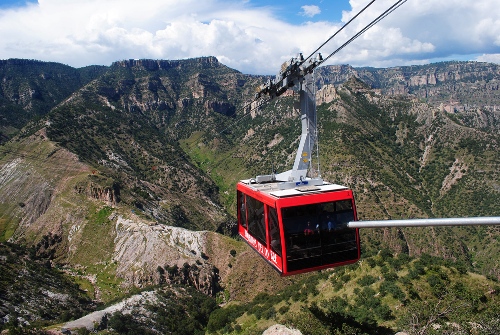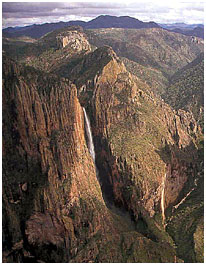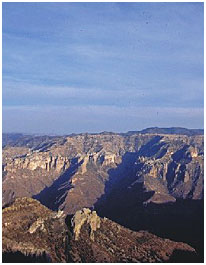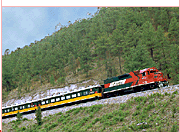
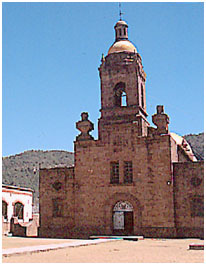
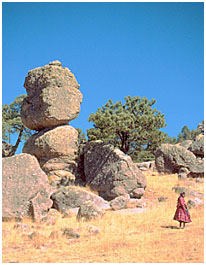
Copper Canyon
Barranca Del Cobre
Ferrocarril Chihuahua al Pacifico
Cobre Cañon
Cobre Canyon
Barranca del Cobre - Copper CanyonThe train thru Barranca del Cobre or Copper Canyon and this includes prices in PESOS, not dollars!
You can also take the bus.
Copper Canyon in Mexico is about four times as large as the Grand Canyon in Arizona. Copper Canyon is also deeper then the Grand Canyon. But Copper Canyon isn’t as pretty as the bright red Grand Canyon.
One cool thing you can do is take the railroad and view Copper Canyon on it.
The railroad which is named “Ferrocarril Chihuahua al Pacifico” or “Chepe” will take you from the city of Los Mochis, Sinaloa which is on the Pacific Ocean thru Copper Canyon to the city of Chihuahua, Chihuahua.
You can book a tour for a $1,000 or more or you can take the railroad on your own for a measly $63 for 2nd Class or pay a shocking $120 for the one way trip on First Class.
You can stop at several points on the train trip and stay overnight and continue the next day. Either way the price of the total train trip is the same.
I got this stuff from a book in the REI store on 48th Street & Southern in Tempe.
| $63 | 2nd class | from Los Mochis to Chihuahua |
| $120 | 1st class | from Los Mochis to Chihuahua |
- Los Mochis more
- Sufragio more
- El Fuerte more
- Loreto more
- Temoris more
- Bahuichivo more
- Cuiteco more
- San Rafael more
- Posada more
- Divisadero more
- Pitorreal more
- Creel more
- San Juanito more
- La Junta more
- Cuauhtemoc more
- Chihuahua more
This is the main web site of the Mexican Railroads or Ferrocarril Mexicanos as they are called in Spanish.
This is a map of the Mexican Railroads or in Spanish un mapa de los Ferrocarril Mexicanos Rutas.
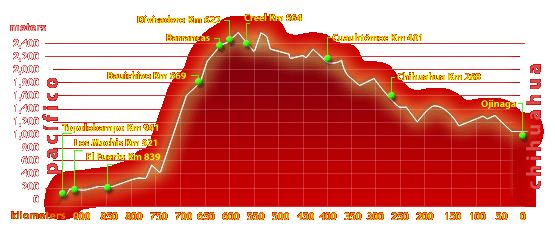 \
\
Mexico’s Copper Canyon beckons thrill-seekers with a tram
At Mexico's Copper Canyon, a new tram started running Sept. 25, 2010.
In the Mexican state of Chihuahua, where local leaders have been trying to lure adventure travelers to the desert despite persistent drug-war troubles, many tourism officials believe their future is up in the air.
About 1,475 feet up, in fact.
That’s the altitude of a new aerial tram designed to take tourists from the rim of the region’s famed Copper Canyon down into its depths. The tramway (teleférico) opened Saturday at Divisadero, a rim-top stopping-point along the Copper Canyon rail route with commanding views of the Urique River.
The tram system and a series of new zip lines are part of the fledgling Barrancas del Cobre Adventure Park, which state officials are hoping will bring an influx of tourists. With that in mind, these officials are laying plans for a new airport in the nearby city of Creel.
The new tram system’s two red cabins (capacity: 60 passengers each) alternate traveling 1.7 miles between Divisadero, where a new restaurant features glass flooring, and a station about 1,150 feet below. The tram ride takes about eight minutes. At some points, the cabins are as much as 1,475 feet above ground.
The system was built by the Swiss-Austrian firm Doppelmayr, and state officials estimate the overall cost at $29.4 million. Passengers pay about $20 for a ride.
For an additional $48, the more adventurous can try seven new zip lines (tirolesas) that cover 1,700 feet to 3,600 feet each, ending at the lower tramway station. Mountain-bikers can also use the tram.
About 2,000 passengers rode the tram on its first day, said Sonia Estrada Morales, director of promotion for Chihuahua State Tourism Department.
Though plans for expansion and its impact on local nature and culture are still under discussion, Estrada said, tram passengers may eventually be able to transfer to several smaller gondolas (holding eight persons each) that will travel another 1.7 miles down to the river’s edge. Also on the drawing board: observation towers and a hot-springs resort.
Winning over American travelers, however, may not be easy. The state of Chihuahua, Mexico’s largest, is among those with high levels of drug-ware crime, including 1,491 drug war-related deaths in the first half of 2010, by the count of the San Diego-based Trans-Border Institute.
On the same day that the local newspaper El Diario carried word of the new cableway at Divisadero, another headline noted a controversy in the town of Ascension (about 200 miles north of Divisadero) over the recent lynching of two men after the attempted abduction of a minor.
Estrada said most of the state’s crime was in bigger cities to the north and that in the Copper Canyon area “up to this day, no visitor has been injured” in any incidents related to the drug war.
Copper Canyon is really a series of canyons about 370 miles long and 150 miles wide. The average depth is between 5,000 and 6,200 feet, and parts are deeper than the Grand Canyon.
Since the early 1960s, the main way for tourists to see the landscape has been the Chihuahua-Pacífico train (a.k.a. El Chepe, a.k.a. the Copper Canyon Railroad) that rolls between the city of Chihuahua in the north and Los Mochis, on the Pacific coast, to the south.
But in the 1990s, the area began growing as a fledgling adventure-travel destination, with mountain-bikers following old Tarahumara footpaths near the towns of Creel (on the rim) and Batopilas (at the bottom).
— Christopher Reynolds / Los Angeles Times staff writer
